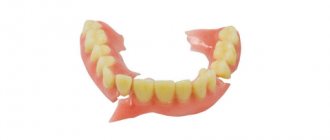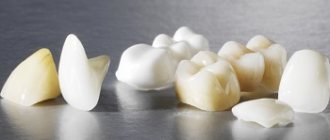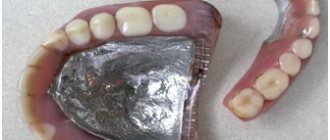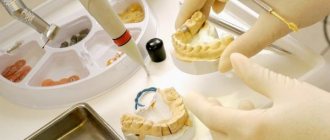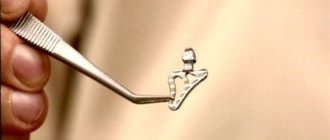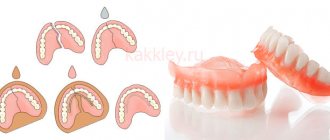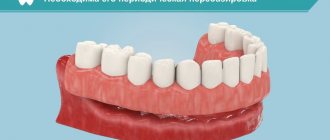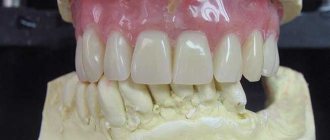What is a removable plate prosthesis?
A removable plate prosthesis is a base made of polymer materials into which artificial teeth are inlaid. This design is used in the absence of several or all jaw teeth, and due to the low cost and ease of manufacture, removable plastic laminar dentures are very popular among patients.
Indications
The indications for the use of removable plate dentures for teeth are very wide, since there are much fewer restrictions for this type of system than for implantation or classical dental prosthetics. In particular, these are:
- complete or partial edentia;
- impossibility of implantation or classical prosthetics (for clinical or financial reasons);
- the need to wear temporary structures before installing permanent dentures;
- allergy to metal.
Contraindications
- severe periodontal diseases;
- problems of the circulatory system;
- undergoing a course of radiation or chemotherapy;
- mental illness.
The materials for making plate dentures are usually plastic, acrylic, nylon or polyurethane. Often, it is the composition that largely influences the final cost of the design: modern plate dentures are made of hypoallergenic acrylic or nylon, which ensures comfortable wearing and almost completely eliminates allergic reactions. Based on appearance and functionality, these prostheses are divided into two types: partial laminar dentures and complete laminar dentures. Let's look at these systems in more detail.
When are removable dentures of the described type fixed?
A partially removable plate product can help a patient out for a short period when the product is being prepared for permanent wear. Other indications for wearing prostheses include:
- absence of chewing teeth in the presence of supporting teeth;
- the presence of restrictions on the installation of implants;
- allergy to materials used in the manufacture of permanent structures.
The same type of prosthetics is offered if the patient is unable to pay for fixed products.
Partial plate denture
A partial removable plate denture replaces one or more lost teeth, so its shape and size directly depend on their number. To install such a prosthesis, you do not need to grind down the adjacent teeth: fixation of partial removable laminar dentures is carried out in several ways.
Types of fixation of removable laminar dentures:
Metal clasps
Hook-shaped processes starting at the base of the prosthesis and clasping the neck of the supporting tooth. Currently, they are rarely used, as they can damage tooth enamel.
Metal-free clasps
A more modern variation of conventional clasps. Made from soft, metal-free materials.
Attachmen
Small clasps that are installed on the prosthesis itself and the supporting teeth. When installing the structure, these parts are securely fixed.
Complete removable plate denture
Removable laminar dentures in the case of complete absence of teeth simulate the patient’s upper or lower jaw, so that they are significantly larger in size than removable laminar dentures in the case of partial absence of teeth. As a rule, such a design has a rather voluminous base (especially a plate prosthesis for the upper jaw), which is necessary in order to achieve a tight fit and ensure more or less stable fixation.
Methods of fixation of complete removable laminar dentures:
Clasps or attachments
Such fixation methods are used if at least a pair of healthy teeth remain on any of the jaws.
Suckers
Additional fixation elements that are usually used when a complete removable plate denture is installed on the upper jaw.
Fixation on implants
Installation of a prosthesis supported by implants. This is the most reliable, expensive and durable method of prosthetics, which is not always possible due to contraindications to implantation and the high cost of the technique.
Service life and care rules
The need to change a complete removable denture is associated with:
- change in a person's age:
- general condition of the oral cavity and natural teeth;
- wear of the orthopedic structure.
The reason for replacement may be worn crowns or cracks. Food penetrates into the resulting holes, causing inflammation in the mucous membrane. The patient feels discomfort, pain, and inflammation may appear. Breakage of the prosthesis is also possible. Causes:
- Errors made during production in the laboratory. For example, incorrect definition of the bite, non-compliance with the polymerization regime or incorrect positioning of the teeth.
- Poor hygiene. If a person does not properly care for the structure and often drops it, the body may crack or break.
- A change in its position in the oral cavity due to a decrease in the soft and hard tissues of the alveolar processes. In simple words - due to atrophy.
Such corrections do not take much time; you should not wait until the last minute to visit the clinic. Dentures need to be replaced after 3-5 years.
Tips for proper care
The care system depends on what type was installed. After the procedure, the dentist gives recommendations on:
- general hygiene;
- food restrictions;
- proper and daily cleansing.
Dentures require a lot of attention from the owner. For example, for careful care of the oral cavity and the structure itself. Why is daily hygiene important? It will help maintain the original appearance of the structure, and also prevent the occurrence of infection and inflammation of the gums.
Removable dentures need to be washed. This must be done after eating. Warm, running water is suitable for this. The product should be cleaned with a soft toothbrush and fine toothpaste. It is advisable to soak in a special solution with a bioformula for 10-20 minutes 2 times a day. If the patient is accustomed to removing the prosthesis at night, it must be placed in water or a special solution for storing such structures. It is forbidden to put it in hot water; high temperatures may cause it to become deformed.
Proper hygiene procedures do not exclude the appearance of plaque on the surface of the prosthesis. Once every six months you need to take it for professional cleaning.
Are there any restrictions on food consumption? Patients should not eat sticky, viscous foods. For example, chewing gum, toffee, etc. For the first time after installation, you should not eat solid food. However, immediately after installation, a person can eat fruit; they need to be cut into small slices - this will allow them to train the chewing skill.
Removable dentures restore lost functions in the absence of teeth. But it’s worth remembering the most important thing. If the orthodontic design causes discomfort, you should immediately contact your dentist. He will make corrections and order adjustments to the product in the laboratory.
Calculator: calculate prices online
Calculation of the cost of removable dentures
Calculate the cost of removable dentures yourself
Select the type of removable denture
1
Select the number of dentures: 1 or 2
+ The cost of casts is 1200 rubles.
Better and more accurate - in a free consultation! All addresses and telephone numbers are on the website chudostom.ru. Make an appointment by calling the branch closest to you.
The calculation is not a public offer; the final cost is determined at a free consultation BEFORE the start and does not change during the treatment process.
Total cost rub.
0
Manufacturing of plate dentures
The technology for manufacturing a plate prosthesis is considered simpler compared to the creation of most fixed structures (crowns or bridges), so the patient receives a ready-made system quite quickly (unless we are talking about installing implants).
Manufacturing stages:
- Initial consultation, examination, creation of panoramic images of the jaw and approval of the design of the prosthesis.
- Taking impressions and making a model of the patient's jaw. Determination of bite parameters.
- Making and fitting of a wax structure.
- The final stage of manufacturing a plate prosthesis, polishing the finished structure and eliminating cosmetic defects.
- Fitting and installation of the finished structure.
Advantages and disadvantages
Prosthetics with plate prostheses have a number of advantages and disadvantages, which may vary depending on the type of structure. Before agreeing to have dentures installed, find out all the strengths and weaknesses of your new teeth. In addition, your attending physician should tell you about the types of plate prostheses and help you choose the best option.
- fragility (under heavy loads, a fracture of the plate prosthesis often occurs);
- short service life (up to 5 years);
- certain discomfort when wearing and difficulty getting used to (this applies to a greater extent to outdated designs);
- no load on bone tissue (except for installation supported by implants).
- ease of manufacture;
- low price. Prosthetics with removable plate dentures are considered one of the most cost-effective options for dental restoration in orthopedics;
- restoration of chewing function of teeth;
- acceptable appearance.
“Both sides of the coin” of a partial denture
| Advantages of a plate prosthesis | Disadvantages of a prosthesis on plates |
| — uniform distribution of load during chewing - ease of care - short production period - relatively low cost — possibility of installation without the need for preparation - no age restrictions for wearing | - fragility of the material - the prosthesis cannot be subjected to aggressive chewing load – short service life – 5 years — difficulties in the process of getting used to the products (feeling of a foreign body in the mouth, rubbing of the gums) - manifestation of diction disorders during the period of addiction; — the possibility of bone tissue atrophy (not relevant when installing prostheses on implants) — the occurrence of a “greenhouse effect” (temperature difference under the prosthesis and outside it) - can lead to the appearance of bad breath |
Repairing a plate denture for teeth
Constructions of this type are considered quite fragile, especially at the point where the soft supporting part is attached to the artificial teeth. Repairing removable plate dentures is not always possible, and the degree of its success depends on the nature of the damage. In case of minor chips or breakage of clasps and attachments, restoration of removable plate dentures is often carried out, but in case of serious damage, the design usually has to be completely changed. The main reasons for the breakdown of plate dentures usually lie in careless handling (which often leads to falls of the structure) and attempts to bite through hard objects with dentures (for example, nut shells).
